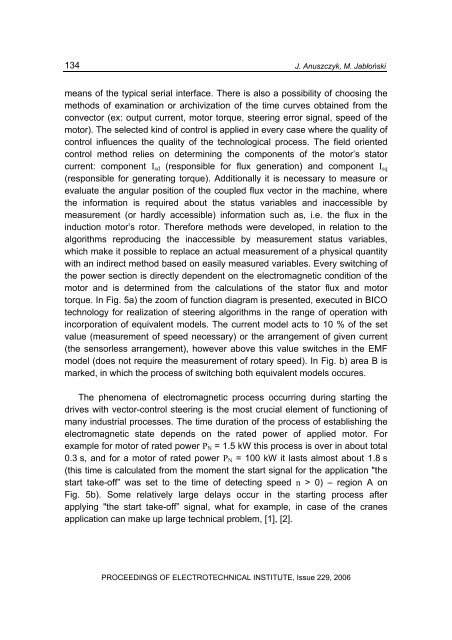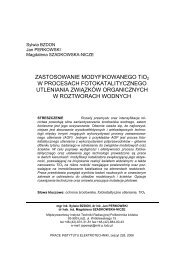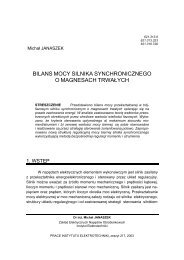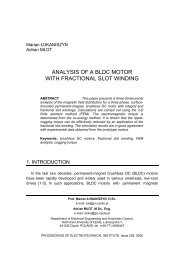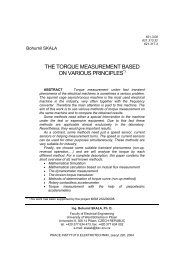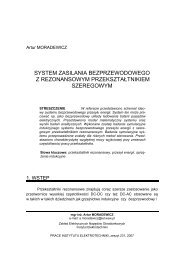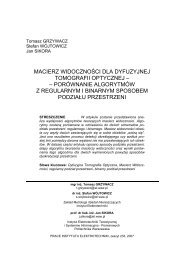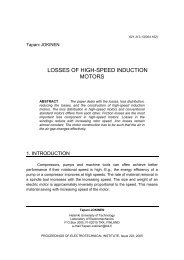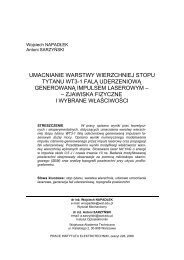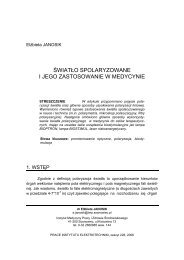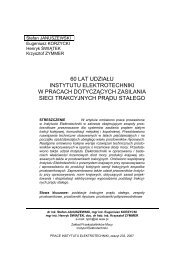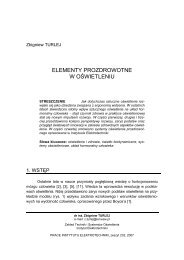representation of an induction motor in field-oriented steering ...
representation of an induction motor in field-oriented steering ...
representation of an induction motor in field-oriented steering ...
You also want an ePaper? Increase the reach of your titles
YUMPU automatically turns print PDFs into web optimized ePapers that Google loves.
134<br />
J. Anuszczyk, M. Jabłoński<br />
me<strong>an</strong>s <strong>of</strong> the typical serial <strong>in</strong>terface. There is also a possibility <strong>of</strong> choos<strong>in</strong>g the<br />
methods <strong>of</strong> exam<strong>in</strong>ation or archivization <strong>of</strong> the time curves obta<strong>in</strong>ed from the<br />
convector (ex: output current, <strong>motor</strong> torque, steer<strong>in</strong>g error signal, speed <strong>of</strong> the<br />
<strong>motor</strong>). The selected k<strong>in</strong>d <strong>of</strong> control is applied <strong>in</strong> every case where the quality <strong>of</strong><br />
control <strong>in</strong>fluences the quality <strong>of</strong> the technological process. The <strong>field</strong> <strong>oriented</strong><br />
control method relies on determ<strong>in</strong><strong>in</strong>g the components <strong>of</strong> the <strong>motor</strong>’s stator<br />
current: component I sd (responsible for flux generation) <strong>an</strong>d component I sq<br />
(responsible for generat<strong>in</strong>g torque). Additionally it is necessary to measure or<br />
evaluate the <strong>an</strong>gular position <strong>of</strong> the coupled flux vector <strong>in</strong> the mach<strong>in</strong>e, where<br />
the <strong>in</strong>formation is required about the status variables <strong>an</strong>d <strong>in</strong>accessible by<br />
measurement (or hardly accessible) <strong>in</strong>formation such as, i.e. the flux <strong>in</strong> the<br />
<strong><strong>in</strong>duction</strong> <strong>motor</strong>’s rotor. Therefore methods were developed, <strong>in</strong> relation to the<br />
algorithms reproduc<strong>in</strong>g the <strong>in</strong>accessible by measurement status variables,<br />
which make it possible to replace <strong>an</strong> actual measurement <strong>of</strong> a physical qu<strong>an</strong>tity<br />
with <strong>an</strong> <strong>in</strong>direct method based on easily measured variables. Every switch<strong>in</strong>g <strong>of</strong><br />
the power section is directly dependent on the electromagnetic condition <strong>of</strong> the<br />
<strong>motor</strong> <strong>an</strong>d is determ<strong>in</strong>ed from the calculations <strong>of</strong> the stator flux <strong>an</strong>d <strong>motor</strong><br />
torque. In Fig. 5a) the zoom <strong>of</strong> function diagram is presented, executed <strong>in</strong> BICO<br />
technology for realization <strong>of</strong> steer<strong>in</strong>g algorithms <strong>in</strong> the r<strong>an</strong>ge <strong>of</strong> operation with<br />
<strong>in</strong>corporation <strong>of</strong> equivalent models. The current model acts to 10 % <strong>of</strong> the set<br />
value (measurement <strong>of</strong> speed necessary) or the arr<strong>an</strong>gement <strong>of</strong> given current<br />
(the sensorless arr<strong>an</strong>gement), however above this value switches <strong>in</strong> the EMF<br />
model (does not require the measurement <strong>of</strong> rotary speed). In Fig. b) area B is<br />
marked, <strong>in</strong> which the process <strong>of</strong> switch<strong>in</strong>g both equivalent models occures.<br />
The phenomena <strong>of</strong> electromagnetic process occurr<strong>in</strong>g dur<strong>in</strong>g start<strong>in</strong>g the<br />
drives with vector-control steer<strong>in</strong>g is the most crucial element <strong>of</strong> function<strong>in</strong>g <strong>of</strong><br />
m<strong>an</strong>y <strong>in</strong>dustrial processes. The time duration <strong>of</strong> the process <strong>of</strong> establish<strong>in</strong>g the<br />
electromagnetic state depends on the rated power <strong>of</strong> applied <strong>motor</strong>. For<br />
example for <strong>motor</strong> <strong>of</strong> rated power P N = 1.5 kW this process is over <strong>in</strong> about total<br />
0.3 s, <strong>an</strong>d for a <strong>motor</strong> <strong>of</strong> rated power P N = 100 kW it lasts almost about 1.8 s<br />
(this time is calculated from the moment the start signal for the application "the<br />
start take-<strong>of</strong>f” was set to the time <strong>of</strong> detect<strong>in</strong>g speed n > 0) – region A on<br />
Fig. 5b). Some relatively large delays occur <strong>in</strong> the start<strong>in</strong>g process after<br />
apply<strong>in</strong>g "the start take-<strong>of</strong>f” signal, what for example, <strong>in</strong> case <strong>of</strong> the cr<strong>an</strong>es<br />
application c<strong>an</strong> make up large technical problem, [1], [2].<br />
PROCEEDINGS OF ELECTROTECHNICAL INSTITUTE, Issue 229, 2006


